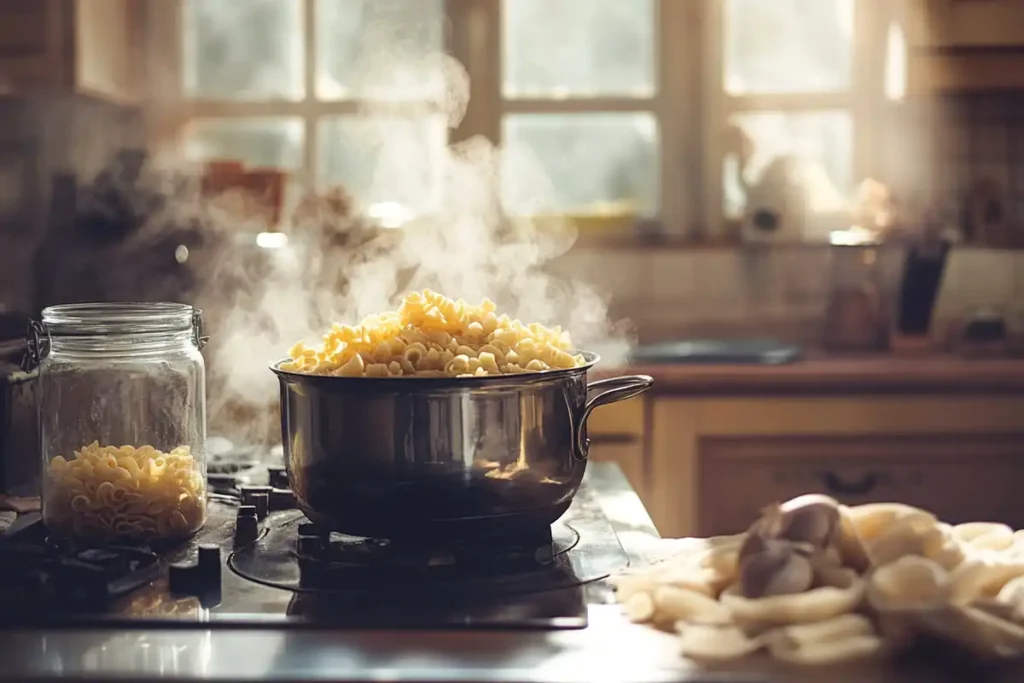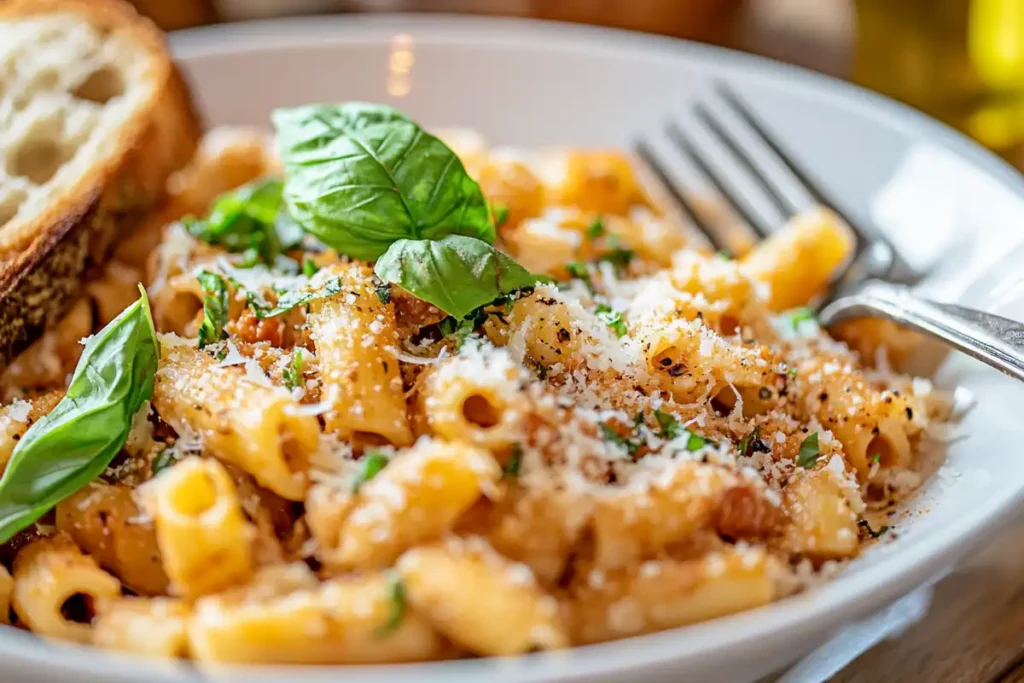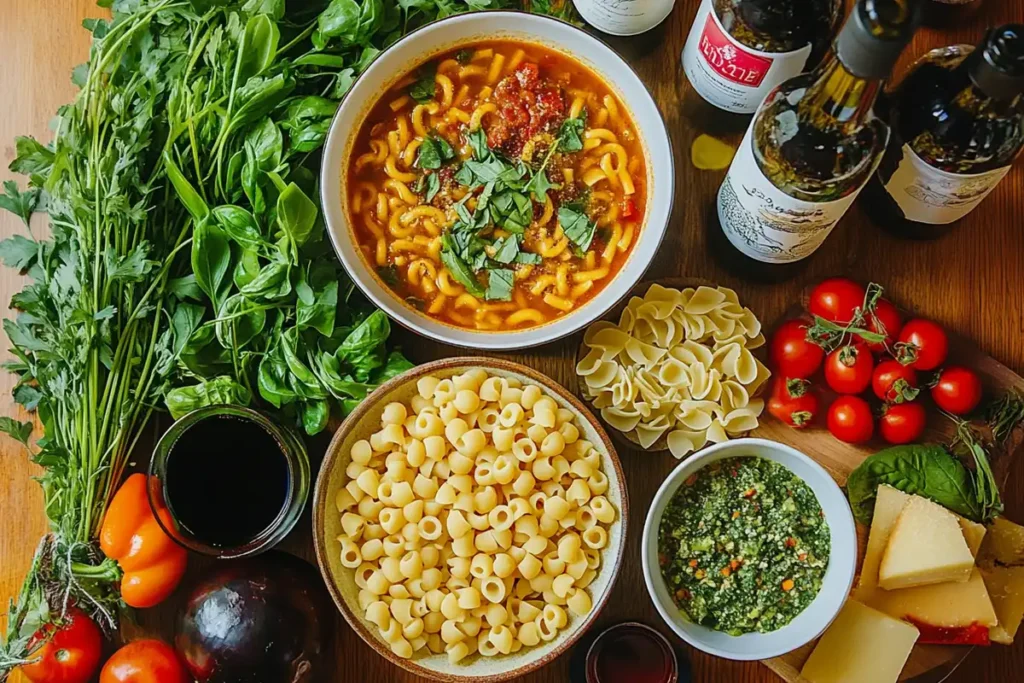Ditalini pasta, those adorable small tubes, are more than just a cute addition to soups—they’re a versatile staple in Italian cooking and beyond. In this guide, we’ll explore everything you need to know about crafting the perfect ditalini pasta recipe. From cooking tips and classic dishes to creative serving ideas, this article will inspire you to embrace this pasta shape in all its glory. Let’s dive into the delicious world of ditalini pasta!
Introduction to Ditalini Pasta Recipes
What is Ditalini Pasta?
Ditalini pasta, sometimes affectionately called “little thimbles,” is a type of small tube pasta originally from Southern Italy. Its name comes from the Italian word ditale, meaning “thimble,” and it’s traditionally used in soups and broths. Thanks to its unique shape, it has evolved to star in various recipes, from creamy casseroles to cold pasta salads.
Why Choose Ditalini for Your Recipes?
Ditalini pasta isn’t just about looks—its compact size and tubular design make it perfect for holding onto sauces, broths, and dressings. Whether you’re aiming for a hearty minestrone or a zesty summer salad, ditalini’s versatility shines through.
Moreover, it cooks quickly, making it a time-saving option for weeknight meals. For anyone who loves pasta but craves more texture and bite in their dishes, ditalini delivers the goods with every spoonful.
Understanding Ditalini Pasta
The Origins and History of Ditalini Pasta
Like most traditional Italian foods, ditalini pasta has a rich history rooted in Italian culinary traditions. It originated in Southern Italy, particularly in the Campania region, where pasta-making flourished for centuries. Its name, derived from “thimble,” reflects its shape—tiny and practical for soups and stews.
Historically, ditalini was an essential ingredient for cucina povera, or “peasant cooking,” as it was economical and filling. It was a staple in dishes that made the most of simple ingredients, like beans, vegetables, and light broths. Today, it’s cherished worldwide for its versatility and compatibility with both traditional and modern recipes.
Traditional Uses in Italian Cuisine
In Italy, ditalini is synonymous with hearty soups. A standout dish is pasta e fagioli, a comforting combination of pasta and beans. This tiny pasta shape is also a favorite in minestrone, where its size makes it easy to enjoy with vegetables and broth in every bite.
Even in baked dishes, ditalini pasta holds its own. Recipes like ditalini with creamy cheeses or tomato-based sauces offer comforting and filling meal options that are still celebrated in Italian households today.
Modern Adaptations and Popularity
The appeal of ditalini pasta has gone far beyond Italy. Today, it’s a global favorite in kitchens and restaurants alike. Chefs love it for its adaptability; home cooks adore it for its ease of use.
From chilled pasta salads with vinaigrettes to baked dishes featuring melted cheese and roasted vegetables, ditalini has become a symbol of how pasta can bridge tradition and innovation. No matter how it’s used, it remains a go-to choice for anyone who craves a versatile pasta shape.
Cooking Ditalini Pasta Perfectly
How to Cook Ditalini Pasta
Cooking ditalini pasta is simple, but achieving the perfect texture requires attention to detail. These small tubes can easily overcook, turning mushy if left unattended. Follow these steps to ensure your pasta turns out al dente every time:
- Bring Water to a Rolling Boil: Use a large pot with plenty of water to allow the pasta to move freely. Add a generous pinch of salt for flavor.
- Measure Your Ditalini: For a single serving, about ½ cup of dry ditalini pasta is usually sufficient. Adjust based on your recipe or number of servings.
- Add Pasta to Boiling Water: Stir occasionally to prevent sticking.
- Check for Al Dente Texture: Cook for 8–10 minutes, tasting a piece at the 8-minute mark. The pasta should be firm but not hard.
- Drain and Rinse (Optional): Strain using a colander. If you’re using ditalini for a cold salad, rinse it briefly with cold water to stop the cooking process.
Boiling Techniques for Al Dente Texture

Perfectly cooked pasta starts with proper boiling. Salting the water is crucial—it enhances the flavor and ensures your pasta doesn’t taste bland. For extra precision, consider these tips:
- Use 4–6 quarts of water per pound of pasta to prevent clumping.
- Stir frequently during the first 2 minutes, as this is when pasta is most likely to stick.
- Avoid adding oil to the water; while it prevents sticking, it can also make it harder for sauces to cling to the pasta later.
Common Mistakes to Avoid
When preparing ditalini pasta, steer clear of these common pitfalls:
- Undercooking or Overcooking: Stick to the package directions and test the pasta early.
- Not Using Enough Water: Crowding the pot can lead to uneven cooking.
- Skipping the Salt: Proper seasoning starts in the pot!
With these techniques in hand, your ditalini will turn out flawlessly, ready to star in any recipe.
Top Ditalini Pasta Recipes to Try
Classic Pasta e Fagioli
Pasta e Fagioli, meaning “pasta and beans,” is an iconic Italian dish where ditalini pasta truly shines. This comforting recipe combines simple ingredients like white beans, tomatoes, garlic, and herbs into a rich and flavorful broth.
- Why Ditalini Works: Its small size and tubular shape are perfect for soaking up the broth while maintaining its texture alongside the beans.
- Quick Tip: Use fresh rosemary and a dash of Parmesan for an extra depth of flavor.
Creamy Ditalini with Cheese Sauce

For a decadent twist, a creamy cheese sauce paired with ditalini pasta creates an irresistible dish. Think of it as an elevated mac and cheese, with a velvety sauce made from sharp cheddar, cream, and a pinch of nutmeg.
- Why Ditalini Works: Its compact size holds the sauce perfectly, ensuring every bite is packed with cheesy goodness.
- Quick Tip: Add crispy breadcrumbs on top and bake for a crunchy finish.
Ditalini Pasta Salad
For a refreshing summer meal, try a ditalini pasta salad. Toss cooked ditalini with cherry tomatoes, cucumbers, black olives, and a light vinaigrette for a bright, zesty dish.
- Why Ditalini Works: Unlike larger pasta shapes, ditalini mixes well with vegetables, ensuring a balanced bite every time.
- Quick Tip: Chill the pasta for at least an hour before serving for best results.
Minestrone Soup with Ditalini
Ditalini pasta adds substance to minestrone, a traditional vegetable-packed Italian soup. With ingredients like zucchini, carrots, tomatoes, and beans, this hearty dish is a wholesome comfort food.
- Why Ditalini Works: It absorbs the flavorful broth without overpowering the fresh vegetables.
- Quick Tip: Cook the pasta separately and add it to the soup just before serving to maintain its al dente texture.
Creative Variations and Serving Suggestions
Ditalini with Pesto and Roasted Vegetables
Looking for a lighter yet flavorful dish? Combine ditalini pasta with a fresh basil pesto and roasted vegetables like zucchini, bell peppers, and cherry tomatoes. This vibrant recipe is ideal for a quick lunch or dinner.
- Why Ditalini Works: Its small size allows it to pair seamlessly with bite-sized veggies, ensuring an even distribution of flavors.
- Quick Tip: Toss the pasta with the pesto while it’s still warm to ensure the flavors meld beautifully.
Ditalini Pasta Bake with Sausage and Spinach
Transform ditalini pasta into a baked casserole with layers of savory sausage, spinach, and mozzarella. Add a rich tomato sauce for a comforting one-pan meal.
- Why Ditalini Works: It holds up well during baking and captures the sauce inside each tube, making every bite delicious.
- Quick Tip: Assemble the dish ahead of time and bake it just before serving for a stress-free dinner.
Cold Ditalini and Seafood Salad
For a sophisticated dish, toss cooked ditalini pasta with chilled shrimp or crab, lemon juice, olive oil, and fresh dill. This light and tangy salad is perfect for summer gatherings or potlucks.
- Why Ditalini Works: Its delicate texture complements tender seafood without overpowering it.
- Quick Tip: Garnish with a sprinkle of capers for added flavor and visual appeal.
Vegetarian Ditalini Stir-Fry

For a fusion twist, use ditalini pasta in a stir-fry. Toss it with stir-fried vegetables like snap peas, carrots, and mushrooms, and coat it with a soy-ginger glaze for an exciting blend of textures and flavors.
- Why Ditalini Works: Its sturdy shape holds up under high heat and pairs surprisingly well with Asian-inspired sauces.
- Quick Tip: Add a handful of sesame seeds and scallions for extra crunch and flavor.
Storage and Reheating Tips for Ditalini Pasta
How to Store Cooked Ditalini Pasta
Proper storage is essential to maintain the texture and flavor of your cooked ditalini pasta. Follow these steps to ensure your leftovers stay fresh:
- Use an Airtight Container: Transfer cooled pasta to a food-safe, airtight container to prevent it from drying out.
- Refrigerate Promptly: Store in the refrigerator within two hours of cooking. Cooked pasta can last up to 3–4 days when stored correctly.
- Avoid Adding Sauce (If Possible): If storing plain pasta, keep it separate from the sauce to preserve its texture.
Freezing Cooked Ditalini Pasta
Yes, you can freeze ditalini pasta! However, for best results:
- Toss in a Little Oil: Lightly coat the pasta with olive oil to prevent clumping.
- Use Freezer-Safe Bags: Portion the pasta into zip-top bags, removing as much air as possible.
- Label and Freeze: Freeze for up to two months.
When ready to use, thaw overnight in the refrigerator or reheat directly from frozen in soups or casseroles.
Reheating Ditalini Pasta
Reheating ditalini pasta can be tricky since overcooking may turn it mushy. Here’s how to do it right:
- On the Stove: Add the pasta to boiling water or a sauce for 1–2 minutes to warm it through.
- In the Microwave: Place the pasta in a microwave-safe dish, cover with a damp paper towel, and heat in short intervals, stirring between.
- In the Oven (For Baked Dishes): Cover the dish with foil to prevent drying, and bake at 350°F (175°C) until heated through.
Tips for Preserving Texture and Flavor
- Don’t Overheat: Warm the pasta just enough to serve without further cooking.
- Add a Splash of Water or Broth: This prevents the pasta from drying out during reheating.
Frequently Asked Questions About Ditalini Pasta
How long does it take to boil ditalini pasta?
Boiling ditalini pasta usually takes about 8–10 minutes to reach al dente, depending on the brand and your preference for firmness. Always refer to the package instructions for the recommended cooking time. To ensure the perfect texture, taste-test a piece a minute or two before the suggested time.
What is the difference between ditali and ditalini pasta?
While ditali and ditalini pasta look similar, the key difference lies in their size. Ditali is larger, making it suitable for chunky sauces and heartier dishes. Ditalini pasta, on the other hand, is smaller and works best in soups, stews, and recipes where smaller pasta complements the other ingredients.
What pasta is closest to ditalini?
If you can’t find ditalini pasta, several other shapes make great substitutes:
- Orzo: Its small, rice-like shape works well in soups and salads.
- Acini di Pepe: These tiny beads of pasta are ideal for brothy dishes.
- Small Elbow Macaroni: Their curve and small size mimic ditalini’s versatility.
Why use ditalini pasta?
Ditalini pasta is a favorite for several reasons:
- Perfect for Soups: Its size and shape make it ideal for soaking up broths.
- Versatility: It transitions seamlessly between hot dishes like casseroles and cold dishes like pasta salads.
- Even Cooking: Its uniform shape ensures consistent cooking, making it a reliable choice for a variety of recipes.
Can you use ditalini pasta in cold recipes?
Absolutely! Ditalini’s compact size makes it a fantastic choice for cold pasta salads. It pairs beautifully with light vinaigrettes or creamy dressings and blends well with chopped vegetables and fresh herbs.
What’s the best way to keep ditalini from sticking?
To prevent sticking:
- Cook the pasta in a large pot with plenty of salted water.
- Stir the pasta occasionally, especially during the first couple of minutes.
- If storing cooked pasta, toss it lightly with olive oil before refrigerating.

